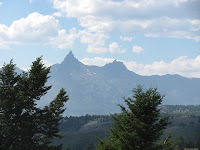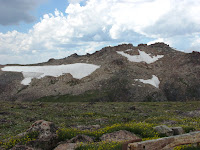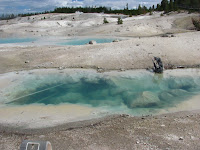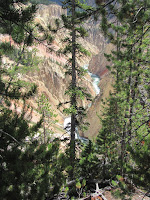*Birds we’ve seen on our 2010 trip so far: white-wing dove, ravens, Gamble’s quail, western tanager, roadrunner, violet-green swallow, California condor, great blue heron, mountain bluebird, wild turkey, black-chinned hummingbird, juniper titmouse, magpie, osprey, Canada geese, bank swallow, common mergansers, American white pelican, Great blue heron, red-tailed hawk, bald eagles
*National Parks/Monuments visited on 2010 trip so far: 24
*State Parks visited on 2010 trip so far: 4
*Total number of Jr. Ranger badges so far: 19
[Click on any picture to enlarge…then arrow back to the blog]
After spending a week at this campground, we moved 5 miles south into the park for a 2 week stay at Mammoth Campground. We arrived at this first-come, non-reservation, no hook-up park at 8am and were lucky enough to snag a great site offering shade in the afternoon, satellite reception, and a beautiful v
We also had the opportunity to meet campground volunteer hosts, Jim and Kay, who do a great job in making sure each camper has an enjoyable stay while there. We were so impressed with how they handled their daily chores that we spent time talking to them about volunteering at a national park. Mammoth Campground, in our opinion, would be the perfect place to volunteer. The area is not only beautiful, teaming with wildlife and thermal activity; it also has internet and satellite service as well as a reasonable commute to stock up the fridge. We are definitely going to investigate a volunteer position for next year.
For those of you who may not remember Charles Kuralt, he was a CBS correspondent, and beginning in 1967 was host of a segment called “On the Road”. Over the next 20 years, he and his crew visited every state in the country in a motorhome, logging more than a million miles. Avoiding the interstates, he
One of the areas he reported on was the Beartooth Highway which he called “the most beautiful drive in America”. This drive originates outside the northeast entrance of Yellowstone and follows Rt. 212 into Montana and back into Wyoming. Along the way you travel through the Gallatin National Forest, Shoshone National Forest, Custer National Forest, through the small towns of Silver Gate, Cooke City, and Top of
most beautiful drive in America”. This drive originates outside the northeast entrance of Yellowstone and follows Rt. 212 into Montana and back into Wyoming. Along the way you travel through the Gallatin National Forest, Shoshone National Forest, Custer National Forest, through the small towns of Silver Gate, Cooke City, and Top of the World, over the Beartooth Pass, and down into Red Lodge, MT. We decided to take the 170-mile roundtrip drive to Beartooth Pass, and on Wed. morning loaded the dogs into the car and headed out. We left with great expectations and in returning 7 hours later, we were not disappointed. We have traveled many scenic and historic roads over the last 3 years, and while each was unique and beautiful in its own right, the Beartooth Highway was definitely
the World, over the Beartooth Pass, and down into Red Lodge, MT. We decided to take the 170-mile roundtrip drive to Beartooth Pass, and on Wed. morning loaded the dogs into the car and headed out. We left with great expectations and in returning 7 hours later, we were not disappointed. We have traveled many scenic and historic roads over the last 3 years, and while each was unique and beautiful in its own right, the Beartooth Highway was definitely  the best.
the best.
From the northeast entrance to the Beartooth Pass was 37 miles of amazing scenery with an elevation change of 3,582 ft. to a height of 10,947 ft. The temperature at the northeast entrance was 78 degrees, and as a storm rolled through while at the top of the pass, the temperature dropped to 48 degrees with a little bit of sleet. Time and again we pulled to the side of the road to tak e in the views. There are 20 peaks soaring over 12,000 feet along the route. In the distance not far to the west Pilot Peak at 11,708 ft. and Index Peak at 11,313 ft. were most impressive. At times we were looking down at glaciers along the mountain sides. Glacial lakes and the round boulders associated with the glaciers of long ago were abundant. Standing there and taking in all the beauty we seemed to be lost in time in trying to imagine what this area looked like millions of years ago.
e in the views. There are 20 peaks soaring over 12,000 feet along the route. In the distance not far to the west Pilot Peak at 11,708 ft. and Index Peak at 11,313 ft. were most impressive. At times we were looking down at glaciers along the mountain sides. Glacial lakes and the round boulders associated with the glaciers of long ago were abundant. Standing there and taking in all the beauty we seemed to be lost in time in trying to imagine what this area looked like millions of years ago.

From the northeast entrance to the Beartooth Pass was 37 miles of amazing scenery with an elevation change of 3,582 ft. to a height of 10,947 ft. The temperature at the northeast entrance was 78 degrees, and as a storm rolled through while at the top of the pass, the temperature dropped to 48 degrees with a little bit of sleet. Time and again we pulled to the side of the road to tak
Did you know that Yellowstone National Park encompasses 2.2 million acres and has quite a diverse landscape? Most people only think of Old Faithful when they think of Yellowstone, but it is so much more...mountains, valleys, canyons, waterfalls, hot springs, bubbling mudpots, and wildlife. On an other day we traveled over 20 miles to the Norris Geyser Basin and then another 12 to the Canyon Village area. Norris Geyser Basin is one of the most active and hottest geyser basins in the park because it is situated on the intersection of 3 major faults. When you really think about the fact that in some areas just 3 to 8 miles below the surface is molten rock (magma), it boggles the mind! We walked the Porcelain Basin trail passin
other day we traveled over 20 miles to the Norris Geyser Basin and then another 12 to the Canyon Village area. Norris Geyser Basin is one of the most active and hottest geyser basins in the park because it is situated on the intersection of 3 major faults. When you really think about the fact that in some areas just 3 to 8 miles below the surface is molten rock (magma), it boggles the mind! We walked the Porcelain Basin trail passin g steam vents, hot springs, fumaroles, and small geysers. The colors created by the thermopiles (heat-loving microorganisms) are spectacular. On the other side at the Back Basin trail we watched the eruption of Steamboat Geyser, the world’s tallest active geyser. Though it can shoot 300 ft. into the air during a major eruption, more commonly it only erupts about 10 – 40 ft. which was the case during our visit. (The last major eruption was in 2005.)
g steam vents, hot springs, fumaroles, and small geysers. The colors created by the thermopiles (heat-loving microorganisms) are spectacular. On the other side at the Back Basin trail we watched the eruption of Steamboat Geyser, the world’s tallest active geyser. Though it can shoot 300 ft. into the air during a major eruption, more commonly it only erupts about 10 – 40 ft. which was the case during our visit. (The last major eruption was in 2005.)

In the Canyon Village area we drove the north and south rim loops of the “Grand Canyon of the Yellowstone”. Carved by the Yellowstone River, this canyon is approximately 20 miles long, more than 1,000 feet deep, and up to 4,000 feet in width. There are two waterfalls – the Up per Falls dropping 109 feet and the Lower Falls plunging 308 feet - that afford many photo opportunities with Artist Point offering the most spectacular view of the Lower Falls (photo at left). Since we had visited this area last year, we didn’t get out at every overlook, but Artist Point is well worth visiting every time. (For more info and pictures on the park, you can click on this link to last year’s visit - 2009Yellowstone).
per Falls dropping 109 feet and the Lower Falls plunging 308 feet - that afford many photo opportunities with Artist Point offering the most spectacular view of the Lower Falls (photo at left). Since we had visited this area last year, we didn’t get out at every overlook, but Artist Point is well worth visiting every time. (For more info and pictures on the park, you can click on this link to last year’s visit - 2009Yellowstone).
In the Canyon Village area we drove the north and south rim loops of the “Grand Canyon of the Yellowstone”. Carved by the Yellowstone River, this canyon is approximately 20 miles long, more than 1,000 feet deep, and up to 4,000 feet in width. There are two waterfalls – the Up
A couple miles from the campground is an area where the Ga

No comments:
Post a Comment